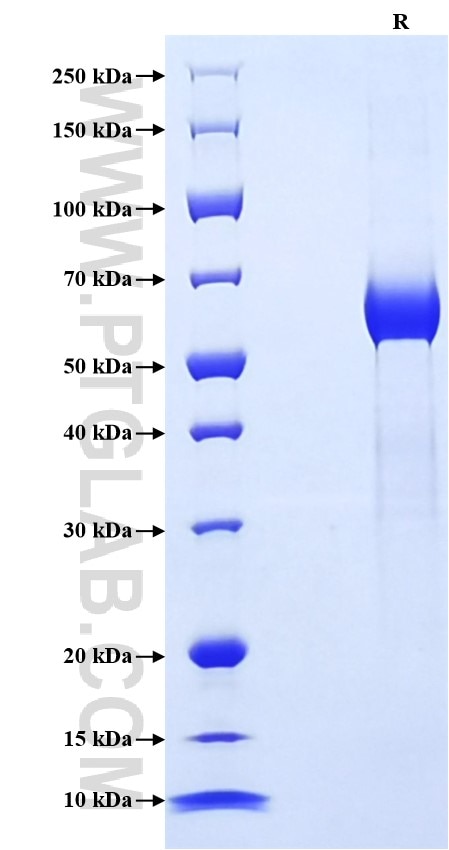Recombinant Human CLEC10A/CD301 protein (rFc Tag)
Species
Human
Purity
>90 %, SDS-PAGE
Tag
rFc Tag
Activity
not tested
Cat no : Eg1892
Validation Data Gallery
Product Information
| Purity | >90 %, SDS-PAGE |
| Endotoxin | <0.1 EU/μg protein, LAL method |
| Activity |
Not tested |
| Expression | HEK293-derived Human CLEC10A protein Gln61-His316 (Accession# Q8IUN9-1) with a rabbit IgG Fc tag at the N-terminus. |
| GeneID | 10462 |
| Accession | Q8IUN9-1 |
| PredictedSize | 56.0 kDa |
| SDS-PAGE | 55-70 kDa, reducing (R) conditions |
| Formulation | Lyophilized from 0.22 μm filtered solution in PBS, pH 7.4. Normally 5% trehalose and 5% mannitol are added as protectants before lyophilization. |
| Reconstitution | Briefly centrifuge the tube before opening. Reconstitute at 0.1-0.5 mg/mL in sterile water. |
| Storage Conditions |
It is recommended that the protein be aliquoted for optimal storage. Avoid repeated freeze-thaw cycles.
|
| Shipping | The product is shipped at ambient temperature. Upon receipt, store it immediately at the recommended temperature. |
Background
C-type lectin domain family 10 member A (CLEC10A), also known as CD301, macrophage galactose-type C-type lectin (MGL), DC-asialoglyco protein receptor (DC-ASGP-R) or human macrophage lectin (HML), is a type II transmembrane glycoprotein having a calcium-dependent carbohydrate recognition domain. CLEC10A is expressed exclusively by myeloid professional antigen-presenting cells such as immature dendritic cells (DCs) and alternatively activated macrophages. CLEC10A is a marker for human CD1c+ DCs (cDC2). It functions as an endocytic receptor for glycosylated antigens.
References:
1. Suzuki N. et al. (1996). J Immunol. 156(1):128-135. 2. Higashi N. et al. (2002). J Biol Chem. 277(23):20686-20693. 3. Valladeau J. et al. (2001). J Immunol. 167(10):5767-5774. 4. van Vliet SJ. et al. (2006). Nat Immunol. 7(11):1200-1208. 5. Heger L. et al. (2018). Front Immunol. 9:744.
